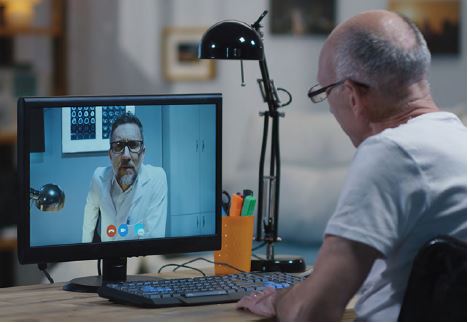How real human experiences can power a healthier future

Maria Raad looks at how we can embrace tech and data science to overcome increasing pressures on healthcare systems.
For the next generation born in the western world, living to be the age of 100 will be the norm. While this seems like a desirable aspiration for our grandchildren, it adds new pressures on our healthcare systems. The number of people living with chronic illnesses will rise year-on-year, and the ongoing management of illnesses like diabetes and cardiovascular disease will require ever increasing resources.
This is nothing new. Healthcare expenditure is growing faster than GDP the world over, a trend that has been amplified by the COVID-19 pandemic. Together, these forces have accelerated technological transformation, acceptance, and adoption across our industry, reinforcing my belief in the ‘triple aim’.
The triple aim considers how we balance the needs of the individual with pressures on our health systems and, in a phrase coined by Berwick, Nola and Whittington in 2008, it is defined as:
- Improving an individual’s experience of care
- Improving the health of populations
- Reducing the per capita costs of care
Changes to any one of these goals can affect the other two, negatively or positively. In order to succeed, we must shift the paradigm of healthcare and drive towards more objective measurements of value and improved experiences for everyone, to create a truly patient-centric system of care.
In the past, our collective adoption of, and trust in, digital technology has been incremental and often reluctant. All too often approached with a narrow mindset, such technologies have been regarded as simply tools to reduce costs or lessen the need for human interaction, when they have the potential to do so much more.
As the scientific evidence behind digital solutions has grown alongside our accelerated need for changes, we’re starting to see the full potential that data science might offer – a potential to create more efficient disease management solutions, reduce the economic burden of healthcare and, most importantly, empower patients to be integral decision-makers in their own care.
Real-time digital solutions for real-world evidence
Two billion people have access to mobile health data, but simply having access is not enough. It is how we use health data that will drive us forward. The emergence of big data, smartphone adoption and cloud storage technologies means that information can be captured in real-time, and then aggregated and analysed to develop new insights.
Collaborations such as HONEUR (Haematology Outcomes Network in Europe) – a partnership of universities, hospitals and institutions across Europe – can help with this by bringing together multiple stakeholders to analyse real-world data (RWD), quickly and at scale, from as many sources as possible. By answering research questions in real time, partners can extract real-world evidence (RWE) that informs their conclusions and accelerates their work.
While acceptance varies between countries, we believe RWE is a key component in moving towards a more value-based healthcare model, as it is one of the few under-utilised resources left in our field.
Healthcare companies are now working with tech companies to put innovative, data-capturing tools directly in the hands of the individual. Wearable tech and mobile health apps can provide patients with information, allow them to manage medication, and help them to become experts in their own condition. This personal depth of knowledge can complement the quantitative data on which we currently rely, so we must ensure it’s integrated into treatment pathways going forward.
Combining digital therapeutics with pharmaceutical innovations
The pandemic has prompted a significant uptake in the use of data technologies. Clinicians, patients and payers are utilising the potential of these platforms, and many are doing so for the first time. We will, however, need to embed such changes across all parts of our healthcare systems, and I believe there are four foundational elements to this:
- Evolving from sick-care to well-care: healthcare systems are struggling to provide care via traditional models, which are largely based on treating illness rather than preventing it. This means moving on from just products and treatments, to platforms and solutions focused on prevention and real-time, outcomes-based care. Digital technology will be a major contributor to this transformational shift from diagnosis and treatment to prediction and prevention.
- Data science: harnessing data networks, artificial intelligence and real-world evidence, and the interdependence between all three, can help move us towards agreeing an objective measure of value for any given therapy. That’s essential if we are to build a new healthcare ecosystem, and if we get it right, everyone will benefit.
- Long life care: ageing populations are growing in size and increasing the pressure on healthcare systems. Without digital technology, the amount of resources required to manage long-term, non-communicable diseases will be unsustainable.
- Personalised care: digital therapeutics, when certified as medical devices, can enable clinicians to prescribe a treatment system that goes beyond the pill. They can also engage patients more effectively in their own care, through real-time symptom monitoring, for example, or by providing physiological support for those dealing with the burden of disease.
- These are not short-term solutions. The ultimate goal is healthcare that’s thriving, sustainable and accessible to all. And we can drive towards that goal by harnessing and sharing the benefits of the ever-evolving technologies within our reach. But it’s a team sport – the days of any individual, organisation, government or industry attempting to change the world on their own are gone.
Data science actually has the potential to make healthcare more human. And, as we look to the next 100 years, with all this technology available to us, perhaps there’s reason to hope that we will yet see a world where fewer people get sick and more people live longer, healthier, happier lives.
This article originally appeared on Pharmaphorum on October 19 2020.


